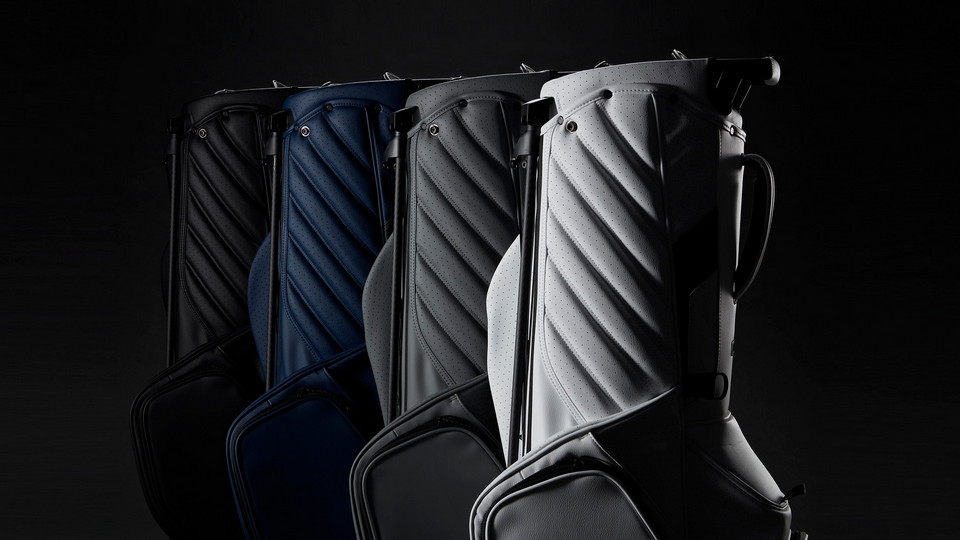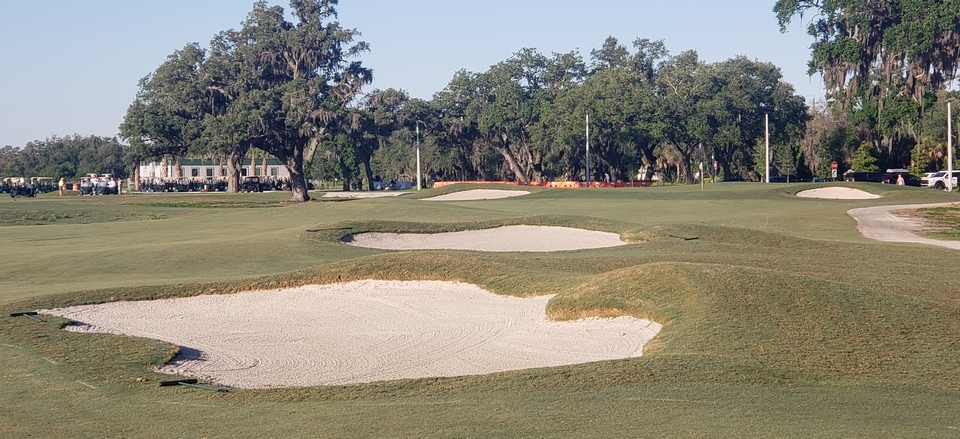Facts and figures about The Open Championship, the Club, the Course and more...
• There have been only three American winners of The Open at Royal St George's: Walter Hagen (1922 & 1928), Bill Rogers (1981) and Ben Curtis (2003). Four Englishmen have won: JH Taylor (1894), Harry Vardon (1899 & 1911), Henry Cotton (1934) and Reg Whitcombe (1938). Two Scots have won: Jack White (1904) and Sandy Lyle (1985). The other winners have been South Africa's Bobby Locke (1949) and Australian Greg Norman (1993)
• The area to the left of the 18th green is properly called "Duncan's Hollow", referring to the 1922 Open when George Duncan, needing a four to tie with Walter Hagen, hit his second into the hollow and then failed to get up and down, handing Hagen the first of his four Open victories. Some however now call it "Sandy's Swale", from where Sandy Lyle also failed to get up and down in 1985. Lyle however had a two-shot cushion, so a five was good enough to take the Championship by one from the late Payne Stewart.
• Three generations of one family held the post of professional at Royal St George's uninterrupted for 77 years: Fred (1911-48), Albert (1948-70) and Cyril Whiting (1970-88). All three were expert club-makers and repairers. In Ian Fleming's 1959 'Goldfinger' novel, when James Bond called into the Royal St Mark's pro shop to have a club made up, the pro was thinly disguised as Alfred Blacking, who had a son named Cyril.
• Fred Whiting's predecessor as professional from 1900-11 was none other than Tom Vardon, younger brother of the great Harry Vardon. A fine golfer in his own right, Tom never won the Open, but he did finish second by six shots to Harry at Prestwick in 1903, and beat his famous brother by one shot the following year at Royal St George's, when they finished fourth and fifth respectively. Indeed, in the six year spell from 1902-07, Tom had a second, a third, a fourth and a fifth, two of those higher than brother Harry. Tom emigrated to the US in 1911.
• 2011 marks the 14th time the Open Championship has been played at Royal St George's, going back to 1894, when it became the first club outside Scotland to host the Championship. It is the fourth most used venue for The Open, and the third most used of the 'active' courses on the current nine club Open rota, behind St Andrews and Muirfield. The occasion will be the 140th playing of the Open Championship.
• The Amateur Championship has been played 13 times at Sandwich, beginning in 1892 and most recently in 2006, making it the third most used course behind Hoylake and St Andrews.
• The first sub-70 round (a 69) in the Open Championship was scored by James Braid in third round of the 1904 Open at Royal St George's, but it was not enough to carry him to victory. He finished tied for second, a shot behind Jack White, who himself shot a 69 in the final round to clinch the title. Tied with Braid for second was JH Taylor, who shot a 68 in the last round, making a trio of scores in the 60s on a single day.
• At Sandwich in 1904, Open Champion Jack White became the first man to record four scores in descending order: 80-75-72-69. The feat has only been achieved on three subsequent occasions, by James Braid at Muirfield in 1906, Ben Hogan at Carnoustie in 1953 and Gary Player again at Muirfield in 1959.
• Yet another record fell in 1904 at Sandwich, when Jack White became the first man to win with a sub-300 total. His 296 beat runners-up JH Taylor and James Braid who also broke the 300 barrier on 297.
• 1904 also saw the Amateur Championship at Royal St George's, where it was won by Walter Travis, the first non-British player to claim this title (Travis was originally from Australia but had taken American citizenship). Having won the 1903 US Amateur Championship, he became the first man to hold both titles simultaneously. He claimed both titles using the new and revolutionary 'Schenectady Putter', invented by Arthur F. Knight, a centre-shafted, aluminium-headed mallet. Such putters would be banned by the R&A in 1910, a ban only lifted in 1952, although they remained legal under USGA jurisdiction. Contrary to popular myth that the ban was motivated by British jealousy, the motive was actually to prevent croquet-style, between-the-legs putting, a style which is still prohibited by both governing bodies to this day.
• Ian Fleming, the creator of James Bond 007, died following a heart attack just four days after being made Captain-elect of Royal St George's in August 1964, aged 56. A keen golfer with a handicap in the high single figures, he had been a member of the Club since 1948. The famous fictional golf game between Bond and Auric Goldfinger took place over a thinly disguised course named 'Royal St Mark's, although the film version of the match was shot at Stoke Poges Golf Club (now Stoke Park).
• The 3rd at Royal St George's is the only par 3 on today's Open Championship rota that has no bunkers, although the hole once had two pot bunkers left of the green. These were filled in before The Open returned to Sandwich in 1981.
• Walter Hagen's victory in the 1922 Open Championship at Sandwich was the first by a US-born American. Jock Hutchison, who won the previous year at St Andrews, became an American citizen in 1920, but was born in Scotland.
• Of the 20 playoffs in the history of the Open Championship, two have occurred at Royal St George's. In 1911 two former Champions, Arnaud Massy (1907) and Harry Vardon (1896, 1898, 1899 and 1903) tied on 303 after four rounds. Playoffs were over 36 holes at the time, but - for only the second time - this one did not go the distance. Massy fell far behind Vardon and conceded on the 35th green, when Vardon holed out for 143 with Massy already on 148 after 34 holes. The second Sandwich playoff came in 1949, when A.D. 'Bobby' Locke defeated Harry Bradshaw 135 to 147 over 36 holes, after both had tied on 283 after regulation play.
• There is no "Bar" at Royal St George's. Instead there is the "Smoking Room", where drink is available but smoking is not permitted.
• The 1938 Open at Royal St George's saw one of the worst storms in Open history, causing havoc with the third and final day's play. The exhibition tent and much of the merchandise on display were destroyed, with debris flying across the course as far as Prince's, almost a mile away. Reg Whitcombe, one of three famous golfing brothers, shot 75-78 to close with a 295 total and win by two shots from Jimmy Adams, while Henry Cotton, who shot a best of the day 74 to add to his earlier 77, finished third on 298. So bad was the weather that of the 37 players who made the cut, 24 failed to break 80 in either of their final two rounds and there were three rounds in the 90s, with only fourteen rounds in the 70s.
• Three multiple Open Champions, with a total of 12 victories between them, won the Claret Jug for the first time at Royal St George's. J.H. Taylor won the first Sandwich Open in 1894 (winning again in 1895, 1900, 1909 and 1913), Walter Hagen in 1922 (winning again in 1924, 1928, also at Sandwich, and 1929) and Henry Cotton in 1934 (as well as 1937 and 1948).
• When Ben Curtis lifted the Claret Jug at the 2003 Open in Sandwich, it was only the 10th occasion that a player had claimed the title at his first attempt. (For the other first time Open winners, click here)
• Greg Norman's winning score of 267 in the 1993 Open at Royal St George's remains the lowest in the history of the Championship, beating the prevous record of 268 achieved by Tom Watson in beating Jack Nicklaus at Turnberry in the 1977 Open 'Duel in the Sun'. At the time, Norman's 267 was the lowest score in any major championship, until finally eclipsed by David Toms' 265 in the 2001 US PGA.
• Norman's closing 64 in the 1993 Open is also the lowest ever final round by a winner of the Championship, although there have been two 63s by non-winners, including Payne Stewart in the same year at Royal St George's. Norman's round could easily have been a 63; he missed a 14 inch putt on the 17th.
• During practice for the 1993 Open John Daly drove the 5th green, 416 yards away, with the help of a strong following wind. However, confirming the often repeated notion that position, more than length, is the key to scoring at Sandwich, more birdies were made in the 2003 Open by players who laid up short of the mounds 320 yards from the tee, than by those who attempted the big carry.
• Sandwich also saw the highest ever finishing round by a Champion in the 1934 Open, when Henry Cotton shot 79 as a result of acute stomach cramps brought on by nerves. However, leading by 10 after three rounds, he could afford this luxury and still won by five shots.
• Reg Whitcombe's 78 in the final round of the 1938 Open at Sandwich was the second highest last round by a Champion (since matched by Fred Daly at Hoylake in 1947). In Whitcombe's defence, the worst storm in Open history was raging, and no player broke 150 for the final two rounds that day. Indeed, only Henry Cotton scored better with 77+74, against Whitcombe's closing 75+78, to finish third.
• At the height of the storm on the final day of the 1938 Open, Alf Padgham found the green on the 384 yard (and downwind!) 11th hole, probably one of the longest drives ever hit in competition at that time. He also holed the putt for an eagle two, finishing the Championship in a tie for fourth.
• Jack Nicklaus has never won as a professional at Royal St George's. Indeed, his worst round as a professional came on this course when he shot 83 (13 over par) in the first round of the 1981 Open, including a run of 6-5-6-5-7 from the 10th to the 14th. To be fair, he had just learned that his son had been charged with an offence after a car crash in Ohio. Whatever the cause, he came back the following day and shot 66, going on to finish in a tie for 23rd on 290, fourteen shots behind winner Bill Rogers. (For the record, the charges against his son were later dropped.)
• Nicklaus did however win the St George's Grand Challenge Cup as an Amateur in 1959 with rounds of 73+76=149.
• The 1904 Open at Sandwich marked the first playing over three days, from June 8-10 (previous 72 hole Opens from 1892 to 1903 had been two-day affairs). With a record field of 144, it was therefore decided to institute a "cut" after two rounds, only 52 players going into the final day's 36 holes.
• Two-ball golf - either singles or (alternate shot) foursomes - is the general rule these days at Royal St George's, except on Tuesdays when three- and fourballs are permitted. A typical members' foursome will complete 18 holes comfortably within three hours.
• The "Great Triumvirate" of Taylor, Vardon and Braid accounted for three of the four Sandwich Opens between 1894 and 1911, JH Taylor once (1894) and Harry Vardon twice (1899 & 1911). Braid didn't win here, although he did come second alongside Taylor in the 1904 Open, won by Jack White.
• Two players have won The Open twice at Royal St George's - Harry Vardon in 1899 and 1911, and Walter Hagen in 1922 and 1928. Hagen is the only player to have won two successive playings at Sandwich.
• There have been two wire-to-wire victories in Sandwich Opens: JH Taylor in 1884 and Henry Cotton in 1934.
• In the 1993 Open at Sandwich, Ernie Els became the first man to shoot four rounds in the sixties (68-69-69-68) in an Open Championship, but only finished in a tie for sixth. Shortly afterwards Greg Norman became the second to achieve the feat, winning with rounds of 66-68-69-64.
• The Sandwich Open of 1993 saw the first six-figure prize in Open Championship history, when Greg Norman took away £100,000. In 2011, the Champion is expected to win £850,000, while 10th place will be worth £100,000, out of total prize fund of £4.8m.
• With his 1911 victory at Royal St George's, Harry Vardon became the first man to win The Open Championship in three different decades (1896, '98 & '99, 1903 & 1911). JH Taylor, who won his first Open at St George's in 1894, became the second to achieve this two years later (wins in 1894, 1900 & 1913). Vardon would go on to win six Opens, a record that stands to this day. Gary Player would join their ranks with victories in 1959, 1968 and 1974, but none of these came at Sandwich, which was not on the Open rota during his peak playing period.



